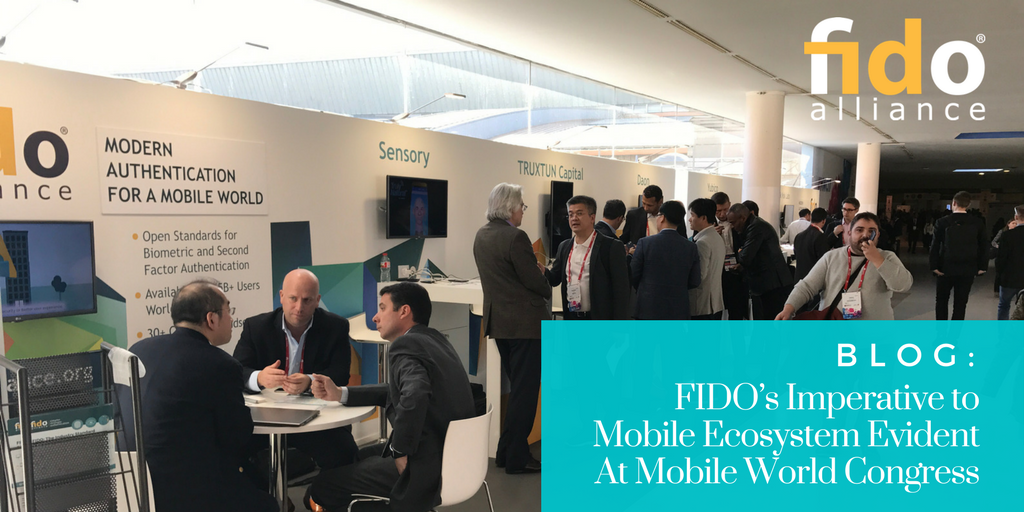
Andrew Shikiar, Senior Director of Marketing, FIDO Alliance
We are back and recovered from Mobile World Congress, which was a great week for the FIDO Alliance! Mobile World Congress is known as the biggest annual gathering for the mobile industry with more than 100,000 attendees. Our experience was filled with positive energy and bustling activity. This year, the FIDO Alliance hosted a pavilion featuring Aware, Daon, Nok Nok Labs, Sensory Inc, TRUXTUN Capital and Yubico. We set up a series of pods on the upper walkway — a great spot where tens of thousands of attendees stopped by to learn more about FIDO’s ecosystem for simpler, stronger authentication.
While MWC once was the show to see the latest mobile devices, it has evolved to include stronger security themes, an area where FIDO Authentication is dominant. FIDO has a clear value in mobile, where the industry is demanding better security features for mobile applications, and consumers are demanding an end to passwords and PINs as security boundaries. The mobile industry is responding by increasingly offering FIDO Authentication built into their flagship devices, and shipping more biometric smartphones. Biometric smartphones are becoming “the new normal” — there was a ten-fold increase of biometric smartphones in the last two years, according to Acuity Market Intelligence. We’re also seeing smartphones being updated to accept FIDO BLE and/or NFC-enabled security keys for authentication, giving consumers even more choice on how they authenticate to services.
Other key takeaways from the event included:
FIDO is the strategy for leading Mobile Network Operators (MNOs). We had many conversations in the FIDO Pavilion and throughout the show with MNOs that have, or are in the process of, rolling out FIDO Authentication. Two of the top reasons: FIDO’s simpler user experience, and the ability to help service providers meet emerging regulatory policies such as PSD2 in Europe.
FIDO fits with GSMA’s Mobile Connect. GSMA’s Mobile Connect provides a universal login solution that matches users to their mobile device, allowing them to log into websites and applications without usernames and passwords. FIDO biometrics is a leading authentication mechanism for Mobile Connect, which Rajiv Dholakia of Nok Nok Labs spoke about at length during the Mobile Connect-themed seminar at the show. The FIDO Alliance is actively working with GSMA on projects that will demonstrate the combined value of Mobile Connect together with FIDO Authentication, so look forward to seeing more from us on that soon.
Securing the Internet of Things is critical. Similar to our takeaways from last month’s RSA Conference, there was a lot of discussion around IoT as it relates to mobile innovation, and the critical need for security in the space. FIDO Authentication is a natural fit for IoT — both for authenticating users to connected devices, as demonstrated by FIDO Alliance members Infineon and Oberthur at the show, and for M2M authentication. Given all of this buzz around IoT, the timing is good for our next webinar, where we will talk in more detail about specific current and emerging use cases for FIDO in IoT.
All and in all, Mobile World Congress was a great experience for the FIDO Alliance as first-time exhibitors, and we already have plans in place to return next year. Are you a mobile ecosystem participant looking to get involved with FIDO? Get in touch with us today.

